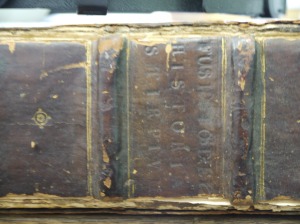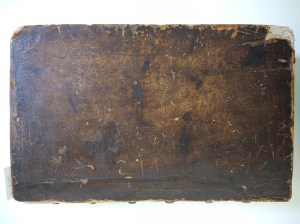Part 3 of this series looks at the conservation treatment involved in stabilising the covers overall and specifically the work involved in the reattachment of the original boards.
Sewing
The original sewing structure displays six double raised leather cords sawn into the textblock which have broken at the joints. As previously mentioned, this has resulted in several pages having become detached from the textblock at both the front and back of the binding. Due to the good condition of the spine leather tightback (that is stuck fast to the textblock) we were unable to view the precise type of sewing structure employed; however it does appear to be intact.
Spine and leather
The leather on the spine is made from calfskin. Acid migration has caused a lower pH of paper at the gutter with some discolouration of the paper at the spine. Sections do show damage at the gutters due to the high acidity of the leather having been adhered straight onto the backs of the sections. There does not appear to be any barrier material between the paper textblock and the adherence of the leather.
On viewing the cover decoration, there is evidence of blind titling (without gold) tooling and in gold tooling on the spine with blind tooling on the sides. The spine leather will require some consolidating in advance of work progressing as it is quite deteriorated at the edges where the board reattachment will take place.
Visual Assessment – Leather and boards
There was no biological damage noted, nor any previous consolidation of boards having taken place either. Under magnification the leather seems to have changed colour over time and has darkened. In making an assessment to see whether leather can withstand interventive technique such as lifting etc. it is recommended that diagnosis and evaluation of the condition of leathers always be made prior to any interventive treatment. The leather on the boards was graded at a level 2-3 and therefore could be retained and worked with.
The book boards have been made up of laminated paste board layers to a depth of 5-6mm. There was some evidence of previous repairs and rebacking. The decision was taken for no intervention on the boards to remove creasing even though unsightly; it would not be adding any strength by trying to reduce it.
There are always various treatment options available in the repair of most bindings. In this instance the priority was to get the book functioning well again whilst retaining as much of the original as possible. The board corners were built up by the insertion of one layer of card and the application of small amounts of paper mache stopping regularly to dry until the corners were strengthened again. Then a final layer of a toned Japanese paper layer was applied to finish.
Sutures were placed down into the spine at stable points allowing both the loose sections to be sewn on and also to draw the boards back on in the first instance.
The boards were re-attached by the work of the sutures and then a layer of Japanese paper was applied both inside and out to strengthen the joints allowing the binding to function again. A final application of a toned Japanese paper followed this.
The choice of Japanese paper rather than leather in this instance was because often the leather requires such fine pairing, and loses physical strength that toned Japanese paper can be appropriate depending on what is being matched in this area. The strength of the repair is underneath where the use of untoned Japanese papers and/or aero linen or cotton is employed depending on the size and weight of the book. Therefore toned and sealed repairs were added as a finishing layer to both the joint areas and board corners.
The final blog will aim to show the finished work on the binding and how to safely store the plant material alongside for future reference with the binding.
Categories: Special Collections









 Johnny Beattie: ‘The Clown Prince of Scotland’
Johnny Beattie: ‘The Clown Prince of Scotland’  The Arte of Faire Writing
The Arte of Faire Writing  Visualizing Collation in the Hunterian Manuscript Collection
Visualizing Collation in the Hunterian Manuscript Collection  Sugar Machines: How Archives in Glasgow hold pieces of Caribbean History
Sugar Machines: How Archives in Glasgow hold pieces of Caribbean History
Brilliant – you book preserving people are SO TALENTED! Lost in admiration …